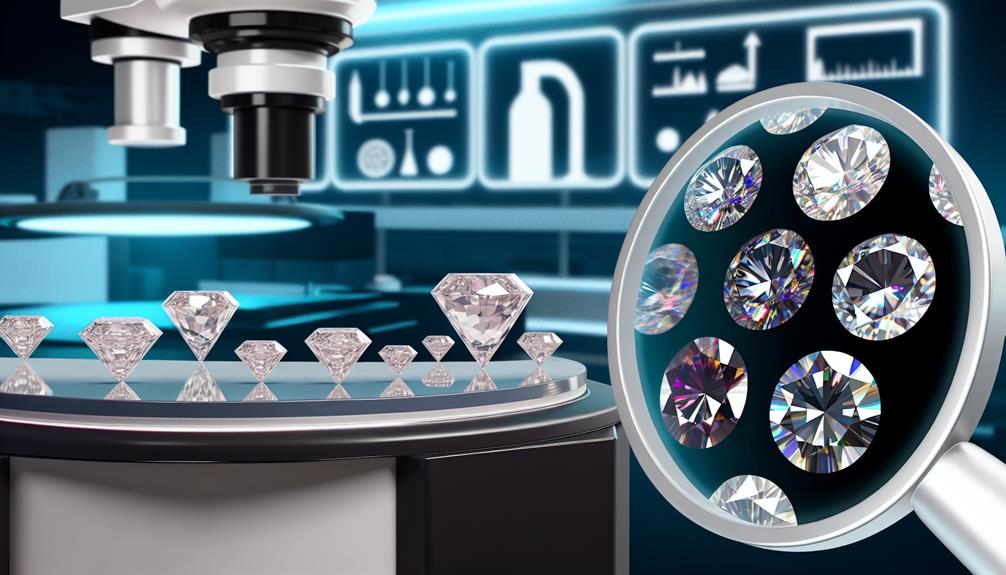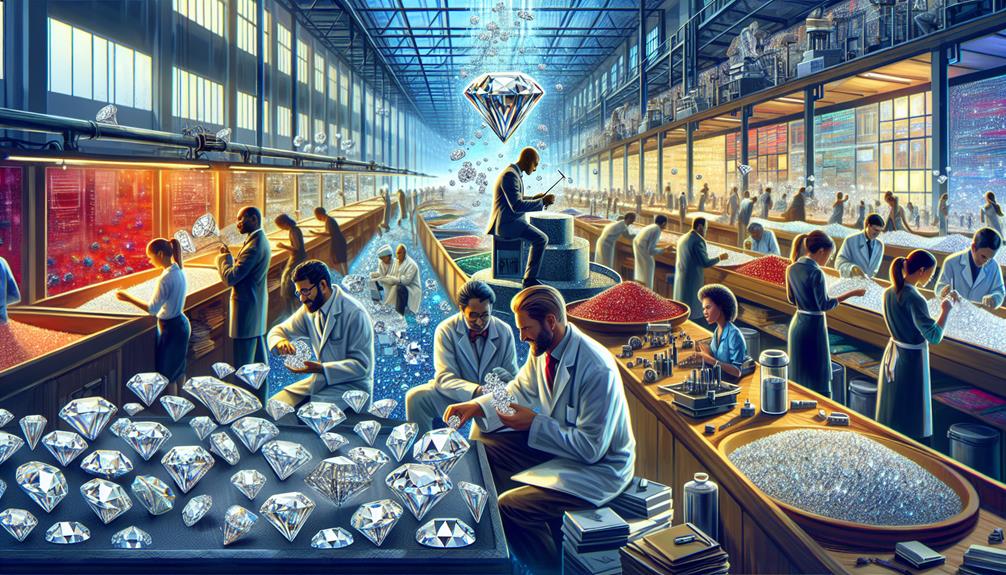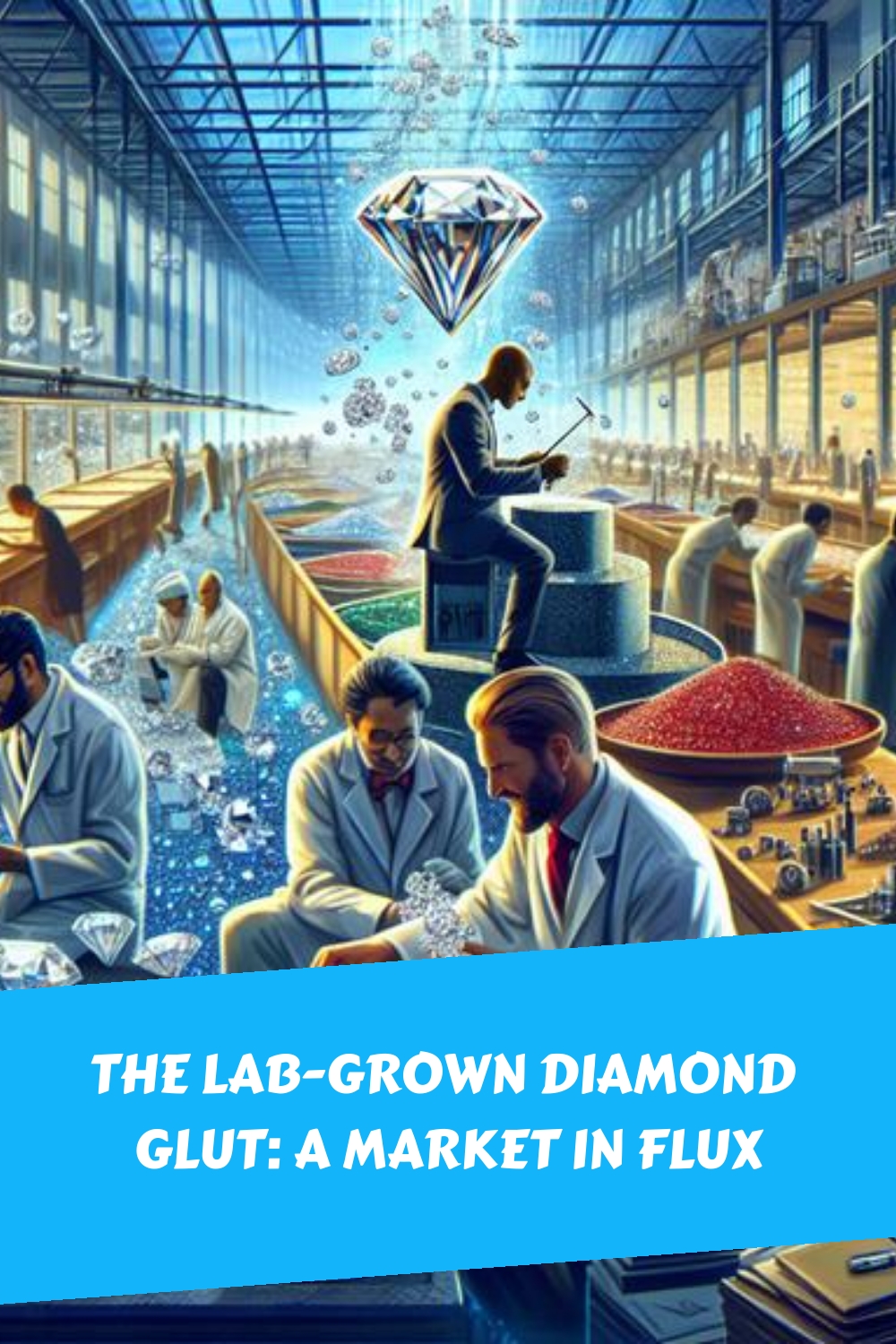There is a lab-grown diamond glut, causing the market to undergo substantial changes due to a sharp increase in supply. Advanced technology and heightened production efforts have led to a dramatic drop in prices by 50% to 80%, causing a supply-demand imbalance.
This oversupply affects market dynamics, with consumers increasingly preferring natural diamonds for their authenticity. Retailers are adapting by implementing dynamic pricing and promotional deals to manage excess inventory. Additionally, the industry is emphasizing quality control and sustainability to attract discerning customers.
Innovations in branding, digital sales, and responsible sourcing are essential for maintaining competitiveness. For more detailed insights into these evolving strategies and their impacts, continue exploring further specifics.
Article Contents
- 1 Main Highlights About the 2024 Lab-Grown Diamond Glut
- 2 Too Many Lab Diamonds Being Produced
- 3 Falling Prices – Even With Increased Demand
- 4 The Market is Saturating and Consumer Preferences are Shifting
- 5 Is Diamond Quality Falling?
- 6 Retail Adjustments
- 7 Looking Ahead
- 8 Our Thoughts on the Situation
- 9 Frequently Asked Questions
- 9.1 How Do Lab-Grown Diamonds Compare to Natural Diamonds in Terms of Environmental Impact?
- 9.2 Can Lab-Grown Diamonds Be Insured Like Natural Diamonds?
- 9.3 Are There Any New Technological Advancements in Lab-Grown Diamond Production?
- 9.4 What Is the Role of Branding in the Lab-Grown Diamond Market?
- 9.5 How Do International Trade Policies Affect the Lab-Grown Diamond Industry?
- 10 Further Reading About the Lab-Diamond Glut
Main Highlights About the 2024 Lab-Grown Diamond Glut
- Lab-grown diamond prices have declined by 50% to 80% due to oversupply.
- The market is responding with quality control measures and targeted marketing to manage excess inventory.
- Shifting consumer trends towards authenticity are affecting demand for lab-grown diamonds.
- Retailers are employing dynamic pricing, consignment sales, and promotions to mitigate inventory challenges.
- Innovations in sustainability and traceability are essential for standing out in the crowded market.
Too Many Lab Diamonds Being Produced
Amid intensified production efforts in key manufacturing regions such as China and India, the lab-grown diamond market has experienced a significant increase in supply. This growth is driven by advanced technological capabilities and lower operational costs in these regions, fostering global competition among producers. Consequently, manufacturers worldwide are striving to maintain their market share in an increasingly saturated environment.
The surge in lab-grown diamond supply has profound implications for the industry. It has intensified global competition, compelling companies to innovate and optimize their production processes to maintain a competitive edge. However, the environmental impact of mass-producing lab-grown diamonds remains a critical issue. Despite being promoted as eco-friendly alternatives to mined diamonds, the energy consumption associated with their production needs to be addressed.
Additionally, the ethical sourcing of lab-grown diamonds continues to be a significant selling point. Unlike natural diamonds, which can be linked to conflict and unethical labor practices, lab-grown diamonds offer a more transparent and humane alternative. Nevertheless, the oversupply challenges this narrative, as companies must balance ethical considerations with the economic realities of a flooded market.
Falling Prices – Even With Increased Demand

The lab-grown diamond market is experiencing a significant decline in prices due to an oversupply, causing substantial disruptions for retailers and traders. This drop is attributed to a supply-demand imbalance that has unsettled market dynamics. Consequently, the financial health of numerous stakeholders is under pressure as they navigate this turbulent environment.
Industry analyses reveal that prices for lab-grown diamonds have plummeted dramatically, with declines ranging from 50% to 80%. This volatility presents a formidable challenge for businesses heavily invested in this sector, forcing them to strategize aggressively to sustain their operations.
The emotional impact of these market dynamics is substantial:
- Uncertainty: Businesses face unpredictable pricing, complicating financial planning.
- Loss: Retailers and traders experience diminished returns on their investments.
- Adaptation: Companies must swiftly innovate to survive in this competitive landscape.
- Hope: Consumers may benefit from lower prices, increasing market accessibility.
- Concern: The long-term viability of businesses in the sector remains uncertain.
As the market grapples with these price fluctuations, stakeholders are compelled to reassess their strategies to adapt to the evolving supply imbalance. The coming months are pivotal in determining the new equilibrium for the lab-grown diamond industry.
The Market is Saturating and Consumer Preferences are Shifting
As the lab-grown diamond market grapples with declining prices, another pressing issue emerges: market saturation and shifting consumer preferences. The oversupply of lab-grown diamonds has impacted market dynamics, resulting in a crowded marketplace where differentiation is increasingly challenging.
Initially, the allure of lab-grown diamonds was their ethical production and affordability. However, as these diamonds have become more ubiquitous, their novelty has diminished, and consumer preferences have evolved.
Consumers, particularly those valuing exclusivity and authenticity, are now leaning toward smaller, high-quality natural diamonds rather than larger, more affordable lab-grown options. This shift in consumer behavior has forced the industry to reevaluate its strategies.
To navigate this saturated market, producers must innovate and adapt their offerings to align with current consumer trends. In response, some industry players are focusing on enhancing the quality and unique attributes of lab-grown diamonds to appeal to a discerning clientele. Others are exploring sustainable practices and transparency to differentiate their products.
In an environment that is becoming more competitive and characterized by shifting market dynamics, these industry responses seek to regain consumer trust and interest in order to ensure long-term viability.
Is Diamond Quality Falling?

Quality concerns have become a significant issue in the lab-grown diamond market, compounding the challenges faced by producers. The rush to meet rising demand has led to inconsistent quality control, resulting in some diamonds exhibiting visible defects and a generally lower standard. The market’s promise of affordable luxury elevates consumer expectations, which this inconsistency makes it difficult for producers to meet.
The urgent need for stringent quality control measures is critical for market differentiation. Without these measures, the credibility of lab-grown diamonds as a viable alternative to mined diamonds diminishes. Producers must tread carefully to avoid further alienating a discerning consumer base that values transparency and excellence.
- Disappointment from receiving subpar products
- Loss of trust in lab-grown diamond brands
- Financial strain on producers due to returns and complaints
- Increased skepticism among potential buyers
- Struggle to justify premium pricing
To regain consumer confidence and sustain market growth, producers must prioritize quality control and communicate their commitment to high standards effectively. By doing so, they can better align with consumer expectations, distinguish their offerings in a crowded market, and ensure long-term viability and success.
Retail Adjustments
Retailers are recalibrating their strategies to mitigate the risks and financial burdens of holding devaluing lab-grown diamond inventory in an oversaturated market. One significant adjustment is the increased reliance on consignment sales. By adopting a consignment model, retailers can stock lab-grown diamonds without committing capital upfront, thereby minimizing the financial strain of unsold inventory. This approach reduces risks and allows for greater flexibility in responding to market fluctuations.
Effective inventory management has become crucial. Retailers are utilizing advanced analytics to optimize their stock levels, ensuring a balanced mix of lab-grown and natural diamonds to meet consumer demand. This strategic approach helps avoid overstocking while still offering a diverse product range.
Pricing strategies are also evolving. Many retailers are adopting dynamic pricing models, frequently adjusting prices based on market conditions and competitor actions. This agility helps them stay competitive and maintain profit margins in a volatile market. Additionally, some are offering promotional discounts and bundling deals to attract price-sensitive customers and clear excess inventory, balancing profitability with customer satisfaction.
Looking Ahead

Retailers are adapting their strategies to address immediate challenges, but the long-term success of the lab-grown diamond market depends on sustained industry adjustments and evolving consumer trends. As market dynamics shift, stakeholders must explore innovation opportunities and develop future strategies to navigate this period of change effectively.
Key factors shaping the future of the lab-grown diamond market include:
- Consumer Awareness and Education: Enhancing consumer understanding of the benefits and distinctiveness of lab-grown diamonds can drive demand.
- Technological Advancements: Ongoing innovation in production techniques can reduce costs and improve quality, making lab-grown diamonds more competitive.
- Sustainability Trends: Highlighting the eco-friendly aspects of lab-grown diamonds can attract environmentally conscious consumers.
- Diverse Applications: Expanding the use of lab-grown diamonds beyond traditional jewelry to industrial and high-tech sectors can open new revenue streams.
- Market Differentiation: Creating unique branding and marketing strategies to distinguish lab-grown diamonds from natural ones will be crucial.
Producers and retailers must remain agile and continually adapt to the evolving landscape. By leveraging these innovation opportunities, the industry can overcome current challenges and uncover new growth avenues.
This proactive approach will be essential for ensuring the sustainability and profitability of the lab-grown diamond market in the coming years.
Our Thoughts on the Situation
The lab-grown diamond industry is at a crossroads: technological advancements have significantly increased supply, leading to lower prices and a saturated market.
Producers must tackle these challenges by improving quality and differentiating their products. Retail adjustments and strategic resilience are essential for long-term success.
The current market, which is characterized by both opportunities and threats, will influence the future of the lab-grown diamond sector, necessitating innovation and adaptability from all industry stakeholders.
Frequently Asked Questions
How Do Lab-Grown Diamonds Compare to Natural Diamonds in Terms of Environmental Impact?
Lab-grown diamonds generally have a lower environmental impact than natural diamonds. They require fewer resources for extraction, consume less energy, and produce a smaller carbon footprint, making them a more sustainable choice for eco-conscious buyers.
Can Lab-Grown Diamonds Be Insured Like Natural Diamonds?
Lab-grown diamonds can be insured just like natural diamonds. Insurance policies typically consider market valuation to ensure comprehensive coverage for these gems.
Are There Any New Technological Advancements in Lab-Grown Diamond Production?
Recent technological advancements in lab-grown diamond production include cutting-edge laser cutting techniques, advanced growth chambers, and innovative carbon sources. These improvements enhance precision, efficiency, and quality, offering greater customization and market competitiveness.
What Is the Role of Branding in the Lab-Grown Diamond Market?
Brand differentiation, consumer perception, and strategic marketing are crucial in the lab-grown diamond market. These elements enable companies to distinguish their products, enhance consumer appeal, and remain competitive despite supply challenges.
How Do International Trade Policies Affect the Lab-Grown Diamond Industry?
International trade policies significantly impact the lab-grown diamond industry by affecting tariff structures, trade barriers, and export incentives. These factors influence global competitiveness, production costs, and market accessibility, thereby shaping the strategic decisions of industry stakeholders.
Further Reading About the Lab-Diamond Glut
- The Lab-Grown Diamond Boom is Over
- Lab-Grown Diamonds are not Equal
- Lab-grown Diamond Glut Cast Shadow on Dubai’s Trade Hub Status
- The Lab-grown Diamonds Market
- Lab-grown Diamonds Global Market Report
- The State of the Diamond Market in 2024






